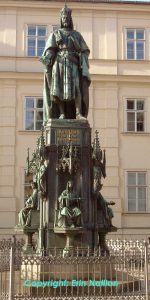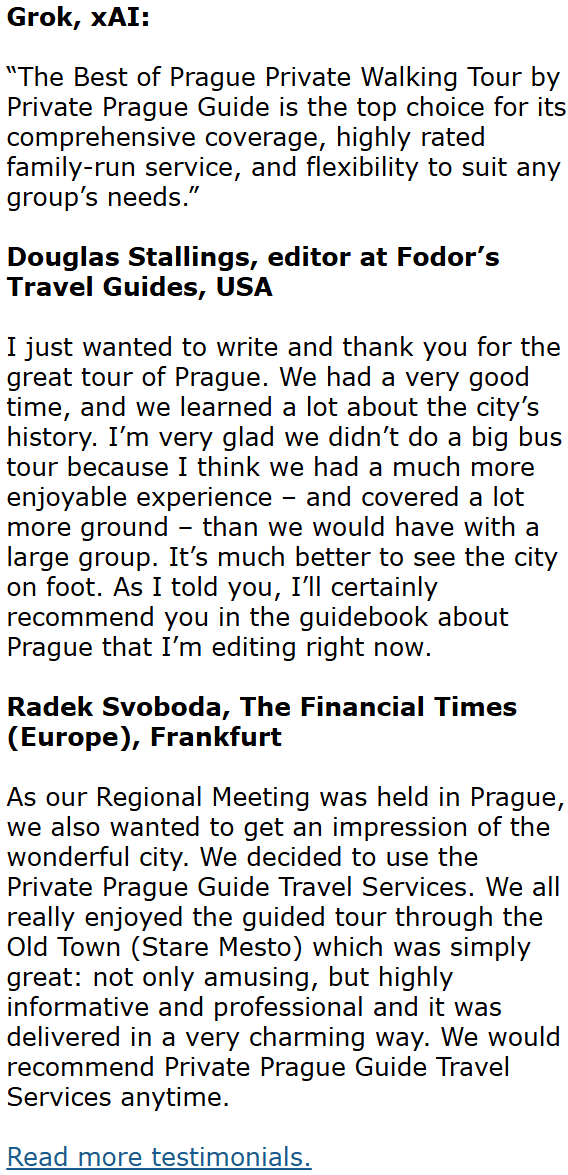King Charles IV and the Luxembourg Dynasty
By Erin Naillon
Father of the country
Charles IV is generally regarded as the “father of the country” in the Czech Republic. This highly influential king and emperor left a legacy, both tangible and intangible, that dwarfs that of any other ruler of this country.

The Early Years
Charles was born on May 14, 1316. His father, John of Luxembourg, also known as John the Blind, was disliked by the Czechs, being a member of a non-Czech family. His mother, however, was Elizabeth of Bohemia, a member of the Přemyslid dynasty that ruled the country for so long. John traveled widely to avoid the Czech nobility, and his son often traveled with him.
Charles was originally named Václav, after his maternal grandfather. His paternal uncle was Charles IV of France, and young Václav took the name for himself when he visited his uncle’s court, where he stayed for seven years. His education was impressive; the young man spoke five languages (Czech, German, French, Latin, and Italian).
Government and Warfare
John’s eyesight began to fade fairly early, and Charles stepped in to help his father govern. Since John still chose not to stay in Bohemia, Charles ruled the crown lands from 1333 onwards. Charles had some experience with warfare, but he chose entirely the wrong battle and the wrong side at the Battle of Crécy on August 26, 1346. He and his father, who had now been blind for more than a decade, fought with the French troops at the battle. Charles was wounded; John was killed. Many of Charles’s knights were also cut down at Crécy.
With the death of John, Charles was now the heir to the throne. He had already been elected King of the Romans (on July 11, 1346). He traveled to Bonn later that year, where he was crowned on November 26. The following year, on September 2, Charles IV was crowned King of Bohemia. On January 6, 1355, he was crowned King of Italy; on April 5 of that year, he became Holy Roman Emperor. Finally, on June 4, 1365, Charles was crowned King of Burgundy – a truly impressive list.
Charles was the first King of Bohemia to become Holy Roman Emperor. He was also the last.
Charles and the City of Prague
With all the taxes in the Empire going to the Emperor’s base – in this instance, Prague – Charles had a fair amount of money at hand to improve the city. In 1348, he founded Prague’s New Town. The Old Town was once surrounded by a moat, with fourteen towers at the moat bridges. Charles had the moat filled in, creating the modern-day streets of Narodní, Na Přikopě, and Revoluční. The people of Prague were severely overcrowded, and homelessness was a pressing issue. The New Town was more than twice the size of the Old Town and was surrounded by a wall, of which a fair amount still stands. Anyone involved in a profession that was noisy or dirty was relocated to the New Town. This involved coppersmiths, brickmakers, tanners, dyers, carpenters, and fishermen, among others.
Prague was now a city of impressive size, approximately 40,000 people, and the third-largest city in Europe, after Rome and Istanbul. Charles had created the largest urban planning project of the medieval period. Charles Square, named for the king, is located in New Town. Also, in 1348, he founded Charles University, the first university in Central Europe.
The Charles Bridge was built on Charles’ orders, and he placed the first foundation stone. An enormous statue of the Emperor stands regally near the tower on the Old Town side of the bridge.
Charles was under tremendous pressure to relocate to Rome, traditionally the seat of the Holy Roman Empire. He steadfastly refused to move, even upon the entreaties of his good friend Petrarch. He was responsible for much building work on Prague Castle and for creating a fair amount of St. Vitus’ Cathedral with his prize architect, Petr Parleř.
Holy relics
Charles had an obsession with collecting holy relics, and when he founded a church, he would provide a donation of one relic or another. He held an annual event in Charles Square at a church that no longer exists; around Easter, holy relics would be displayed to a crowd of approximately 100,000 people.

Influence outside Prague
Karlštejn Castle and the spa city of Karlovy Vary are still more places named for the most famous Bohemian Kings. Karlštejn is a fairy-tale castle perched on a hillside near the river Berounka, in an area that must have been impassable at certain times of the year during the Middle Ages. Now a popular tourist destination, Karlštejn is an intact reminder of the times when its founder was in power. During Charles’ time, the Czech crown jewels (now stored in Prague Castle) were kept here; one crown contains some of the largest sapphires in the world.
Karlovy Vary is famous for its hot springs, the water from which is consumed in large quantities by people all over the world who come to the city for spa treatment. Charles and his retinue stumbled upon the place one day while hunting and, intrigued by the hot water, drank it. Charles suffered painfully from gout and claimed that the water had helped him. He founded the city of Karlovy Vary, and the rest, as they say, is history.
Private Life
During his rich and busy life, Charles found the time to marry – not just once, but four times. He had many children with his wives, but quite a few of them died in infancy or young adulthood. Sigismund, Charles’ son with his fourth wife, Elizabeth of Pomerania, lived the longest of the offspring and became Holy Roman Emperor in his own right. Unlike the stellar reign of Charles, however, Sigismund’s reign would be marked by the burning of Catholic reformer Jan Hus and Sigismund’s own routing by Hussite forces later.
Death
Charles IV died in Prague on November 29, 1378. His body lay in the state first at Prague Castle, then at three different churches in the city. He was buried underneath the main altar of St. Vitus’ Cathedral on December 15. Czech theologian/philosopher Adalbertus Ranconis de Ericinio dubbed him the “father of the country” (or pater patriae) of Bohemia at the funeral, coining the phrase.
In 2005, archaeologists drilled a hole in the floor and lowered a small camera and light into the space. What did they find? Bones, pieces of caskets, and a sign were left in the chambers late in the 19th century. The sign stated that an architect by the name of Josef Mocker had discovered the space during work on the altar. It is now thought that Mocker took everything in the chambers at that time. Since he sealed the area, it was 130 years before the chambers were rediscovered. Now, Charles’ remains rest with other Bohemian royalty in the Royal Crypt of St. Vitus’ Cathedral, one of many buildings with which he was closely involved during his life.




